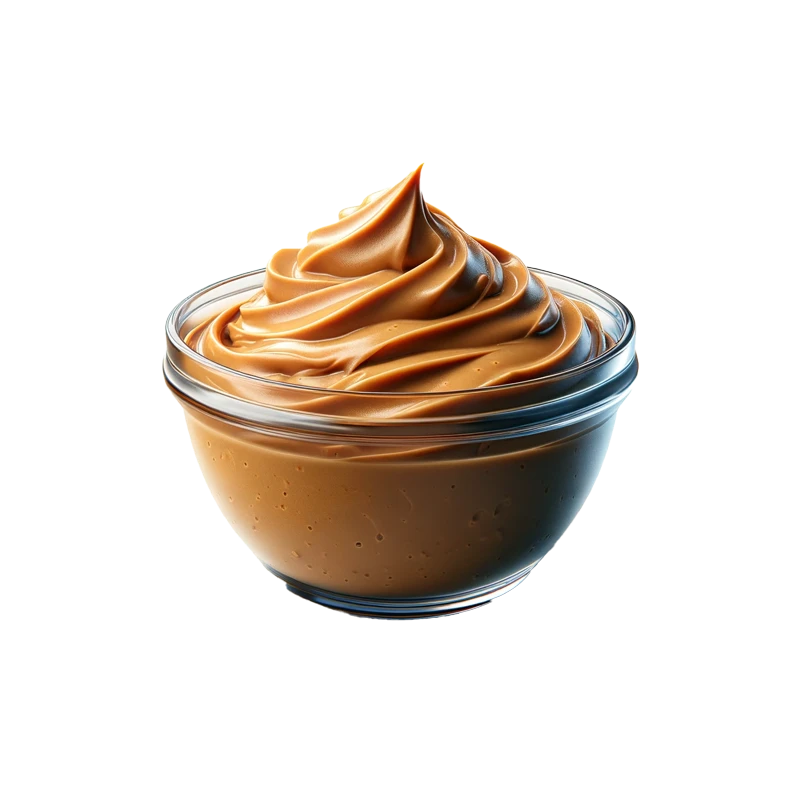Peanut Butter — Nutrients, Health Benefits, And Shopping Tips

Written by Listonic Team
Last update on September 4, 2024
Peanut butter nutrients
Nutrition facts
Amount per 100 g
Calories
🔥 588 kcal
| Nutrition per: 100 g | Value | % Daily Value* |
|---|---|---|
| Carbs | 20 g | 7.27% |
| Fiber | 6 g | 21.43% |
| Sugars | 9 g | 18% |
| Glycemic Index | 14 | - |
| Protein | 25 g | 50% |
| Sodium | 459 mg | 19.96% |
| Total Fat | 50 g | 64.1% |
*The % of Daily Value (DV) tells you how much a nutrient in a serving of food contributes to a daily diet. 2,000 calories a day is used for general nutrition advice.
25 g
💪 High Protein Content
6 g
🥔 Good Fiber Content
Peanut butter facts & tips
Health benefits
- High in protein, essential for muscle growth and repair.
- Rich in healthy fats, particularly monounsaturated fats, which support heart health.
- Contains fiber, promoting digestive health and regular bowel movements.
- Rich in vitamins and minerals such as Vitamin E, magnesium, and potassium, supporting overall health.
Health risks
- High fat content though mostly healthy fats, excessive consumption can still contribute to increased caloric intake and weight gain.
- High calorie content which can contribute to weight gain if consumed in large quantities, particularly as a snack or ingredient in calorie-dense foods.
- Potential for added sugars and trans fats in some commercial peanut butters, which can contribute to weight gain, tooth decay, and increased risk of heart disease.
- Risk of allergic reactions in individuals with peanut allergies, causing symptoms like itching, swelling, difficulty breathing, or anaphylaxis.
How to choose peanut butter
When selecting peanut butter, look for a product that has a creamy texture and is evenly mixed, indicating proper emulsification. The oil should not be separated significantly from the paste, as this can affect consistency and flavor.
Avoid peanut butter that has a dry, crumbly texture or shows signs of oil rancidity, such as a strong, unpleasant odor. Containers that appear tampered with or have mold growth around the rim should also be avoided, as they pose a health risk.

How to store peanut butter
Peanut butter should be stored in a cool, dark place, ideally in a pantry. Keep the lid tightly closed to maintain its freshness and prevent oil separation. Properly stored, peanut butter can last for several months.
Exposure to heat can cause peanut butter to spoil and separate. Avoid storing it near the stove or in direct sunlight. Always use a clean utensil to scoop peanut butter to prevent contamination and ensure it remains fresh. Regularly stirring natural peanut butter helps maintain its consistency.
✅ Extra Tip
How long does it last?
Peanut butter can last for 6-9 months unopened when stored in a cool, dark place. Once opened, it should be consumed within 2-3 months for the best quality.
What to do with leftovers?
Leftover peanut butter can be used in a variety of sweet and savory dishes. Spread it on toast, pancakes, or waffles for a quick breakfast, or mix it into smoothies with bananas and milk for a protein-packed drink. Peanut butter is also great when used as a filling for sandwiches, cookies, or pastries.
Use peanut butter as a base for sauces like a peanut satay sauce for grilled meats or a peanut dressing for salads. If you have a lot of peanut butter, consider making a batch of peanut butter cookies or using it in baked goods like brownies, muffins, or cakes. Peanut butter can also be blended into a dip for fruits and vegetables or used as a topping for ice cream or yogurt. For a quick snack, enjoy peanut butter with apple slices, celery sticks, or crackers, or mix it into a bowl of oatmeal for added flavor and creaminess.
👨⚕️️ Medical disclaimer
Discover products from other categories
Listonic Team
Fact-checked
Our editorial team checked this article to make sure it was accurate at the time of publishing it.
Get the top-rated shopping list app

peanut butter
1 piece
Outline







